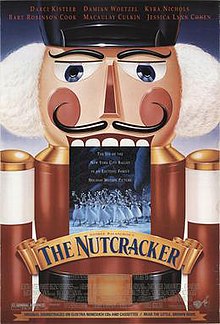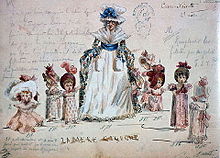The Nutcracker (1993 film)
| The Nutcracker | |
|---|---|
 Theatrical release poster | |
| Directed by | Emile Ardolino |
| Written by | Susan Cooper (narration) |
| Based on | Peter Martins's stage production of The Nutcracker |
| Produced by | Robert Hurwitz Robert A. Krasnow |
| Starring |
|
| Narrated by | Kevin Kline |
| Cinematography | Ralf D. Bode |
| Edited by | Girish Bhargava |
| Music by | Pyotr Ilyich Tchaikovsky |
Production companies | |
| Distributed by | Warner Bros. |
Release date |
|
Running time | 92 minutes |
| Country | United States |
| Language | English |
| Budget | $19 million[1] |
| Box office | $2.1 million[1] |
The Nutcracker, also known as George Balanchine's The Nutcracker, is a 1993 American Christmas ballet film based on Peter Martins's stage production and directed by Emile Ardolino. It stars Darci Kistler, Damian Woetzel, Kyra Nichols, Bart Robinson Cook, Macaulay Culkin, Jessica Lynn Cohen, Wendy Whelan, Margaret Tracey, Gen Horiuchi, Tom Gold, and the New York City Ballet.
The film was released by Warner Bros. under their Warner Bros. Family Entertainment label on November 24, 1993, four days after director Ardolino died. It received mixed reviews and was a box office failure, grossing only $2 million.
Plot
[edit]The film follows the traditional plot of the Nutcracker.
Act I
[edit]Scene 1: The Stahlbaum Home

It is Christmas Eve. Family and friends have gathered in the parlor to decorate the beautiful Christmas tree in preparation for the party. Once it is finished, the children are sent for. They stare in awe at it sparkling with candles and decorations.
The party begins.[2] A march is played.[3] Presents are given out to the children. Suddenly, as the owl-topped grandmother clock strikes eight, a mysterious figure enters the room. It is Herr Drosselmeyer, a local councilman, magician, and Marie's godfather. He is also a talented toymaker who has brought gifts for the children, including four lifelike dolls who dance to the delight of all.[4] He then has them put away for safekeeping.
Marie and her brother, Fritz, are sad to see the dolls being taken away, but Drosselmeyer has yet another toy for them: a wooden nutcracker carved in the shape of a little man. The other children ignore it, but Marie immediately takes a liking to it. Fritz, however, breaks it, and she is heartbroken.
During the night, after everyone else has gone to bed, Marie returns to the parlor to check on her beloved nutcracker. As she reaches the little bed she put it on, the clock strikes midnight and she looks up to see Drosselmeyer perched atop it. Suddenly, mice begin to fill the room and the Christmas tree begins to grow to dizzying heights. The nutcracker also grows to life size. Marie finds herself in the midst of a battle between an army of gingerbread soldiers and the mice, led by their king. They begin to eat the soldiers.
The nutcracker appears to lead the soldiers, who are joined by tin soldiers, and dolls who serve as doctors to carry away the wounded. As the Mouse King advances on the still-wounded nutcracker, Marie throws her slipper at him, distracting him long enough for the nutcracker to stab him.[5]
Scene 2: A Pine Forest
The mice retreat and the nutcracker is transformed into a handsome Prince.[6] He leads Marie through the moonlit night to a pine forest in which the snowflakes come to life and dance around them, beckoning them on to his kingdom as the first act ends.[7][8]
Act II
[edit]The Land of Sweets

Marie and the Prince travel to the beautiful Land of Sweets, ruled by the Sugar Plum Fairy in the Prince's place until his return. He recounts for her how he had been saved from the Mouse King by Marie and transformed back into himself. In honor of the young heroine, a celebration of sweets from around the world is produced: chocolate from Spain, coffee from Arabia,[9][10] tea from China,[11] and candy canes from Russia[12] all dance for their amusement; Marzipan shepherdesses perform on their flutes;[13] Mother Ginger has her children, the Polichinelles, emerge from under her enormous hoop skirt to dance; a string of beautiful flowers perform a waltz.[14][15] To conclude the night, the Sugar Plum Fairy and her Cavalier perform a dance.[16][17]
A final waltz is performed by all the sweets, after which the Sugar Plum Fairy ushers Marie and the Prince down from their throne. He bows to her, she kisses Marie goodbye, and leads them to a reindeer-drawn sleigh. It takes off as they wave goodbye to all the subjects who wave back.
Cast
[edit]- Darci Kistler as The Sugar Plum Fairy
- Damian Woetzel as The Sugar Plum Fairy's Cavalier
- Kyra Nichols as Dewdrop
- Wendy Whelan as Coffee
- Margaret Tracey as Marzipan
- Gen Horiuchi as Tea
- Tom Gold as Candy Cane
- Lourdes López as Chocolate
- Nilas Martins as Chocolate
- William Otto as Mother Ginger
- Peter Reznick as Fritz
- Karin von Aroldingen as Grandparent
- Edward Bigelow as Grandparent
- Heather Watts as Frau Stahlbaum
- Robert LaFosse as Dr. Stahlbaum
- Bart Robinson Cook as Herr Drosselmeyer
- Jessica Lynn Cohen as Marie Stahlbaum
- Macaulay Culkin as The Nutcracker/Prince/Drosselmeyer's Nephew
- Kevin Kline as Narrator
- Katrina Killian as Harlequin
- Roma Sosenko as Columbine
- Michael Byars as Soldier
- Robert D. Lyon as Mouse King
- Maureen C. McFadden Devlin as Drummer
Production
[edit]Development on The Nutcracker began around Christmas 1989, when Peter Martins, Master-in-Chief of the New York City Ballet, learned that Time Warner Entertainment Chairman Steve Ross wanted to produce a film with the company.[18] Bob Krasnow, an avid ballet fan and executive of Time Warner subsidiary Elektra Records, worked on the film as a producer.[18] George Balanchine's trust hired Emile Ardolino to direct the film and Macaulay Culkin was cast as The Nutcracker Prince due to his stardom as well as his experience dancing as “Fritz” for the School of American Ballet during the 1989 and 1990 seasons.[18] Initially there had been talk of hiring a major star such as Dustin Hoffman for the role of Drosselmeyer, but the role ultimately went to dancer Bart Robinson Cook.[18] Ralf D. Bode watched every film version of The Nutcracker to ever be produced in order to decide how he'd shoot the film.[18] During production Culkin's father and manager Kit Culkin repeatedly sparred with the producers often threatening to withdraw his son’s likeness and support in all promotional materials due to Milchan’s refusal to reshoot footage and remix audio as well as removing narration provided by Kevin Kline.[18] Despite Kit Culkin's objections and demands the narration was retained at the behest of George Balanchine's Trustee Barbara Horgan.[18]
Reception
[edit]Critical response
[edit]The film received generally mixed reviews from critics. Based on eight reviews, it holds a rotten rating of 50% on review aggregator Rotten Tomatoes, with an average rating of 6/10.[19] The film was criticized by James Berardinelli for not capturing the excitement of a live performance; he wrote that it "opts to present a relatively mundane version of the stage production...utilizing almost none of the advantages offered by the (film) medium."[20] Roger Ebert of the Chicago Sun-Times was mixed on it, and gave it 2 out of 4 stars criticizing it for not adapting the dance for a film audience and also its casting of Culkin who, he writes, "seems peripheral to all of the action, sort of like a celebrity guest or visiting royalty, nodding benevolently from the corners of shots."[21] In The Washington Post, Lucy Linfield echoed Ebert's criticism of Culkin, stating that "it's not so much that he can't act or dance; more important, the kid seems to have forgotten how to smile...all little Mac can muster is a surly grimace." She praised the dancing, however, as "strong, fresh and in perfect sync" and Kistler's Sugar Plum Fairy as "the Balanchinean ideal of a romantic, seemingly fragile beauty combined with a technique of almost startling strength, speed and knifelike precision."[22] The New York Times' Stephen Holden also criticized Culkin, calling his performance the film's "only serious flaw", but praised the cinematography as "very scrupulous in the way it establishes a mood of participatory excitement, then draws back far enough so that the classic ballet sequences choreographed by Balanchine and staged by Peter Martins can be seen in their full glory."[23]
Box office
[edit]During its theatrical run, the film grossed $2,119,994.[1] In North America, it opened at number 16 in its first weekend with $783,721.[24]
Home media
[edit]George Balanchine's The Nutcracker was released on VHS on October 25, 1994, and on DVD on November 19, 1997, by Warner Home Video.
The film was released on DVD on August 11, 2015, from 20th Century Fox Home Entertainment (now owned by Disney) through their exclusive partnership with Regency Enterprises.
See also
[edit]References
[edit]- ^ a b c "The Nutcracker (1993) - Box Office Mojo". Box Office Mojo. Retrieved 7 November 2014.
- ^ Maximova, Yekaterina; Vasiliev, Vladimir (1967). Nutcracker Suite Performed By The Bolshoi (1967). Moscow, Russia: British Pathé.
- ^ The Nutcracker at the Royal Ballet: "March of the Toy Soldiers". London: Playbill Video. 1967.
- ^ Dancers of the Moscow Ballet (2017). Doll Dance. Moscow, Russia: Moscow Ballet.
- ^ Dancers of the Moscow Ballet (2017). The Rat King Appears. Moscow, Russia: Moscow Ballet.
- ^ Dancers of the SemperOperBallett (2016). Snow Pas de Deux. Dresden, Germany: SemperOperBallett.
- ^ Bolshoi Ballet (2015). The Nutcracker (Casse-Noisette) – Bolshoi Ballet in Cinema (Preview 1). Moscow, Russia: Pathé Live.
- ^ Dancers of the Perm Opera Ballet Theatre (2017). Вальс снежинок из балета "Щелкунчик". Russia: Perm Opera Ballet Theatre.
- ^ Dancers of the SemperOperBallett. The Nutcracker – Arabian Divertissement. Dresden, Germany: SemperOperBallett. Archived from the original on 2020-01-15.
- ^ Cecilia Iliesiu (2017). Arabian Coffee/Peacock. Pacific Northwest Ballet.
- ^ Dancers of the Mariinsky ballet (2012). The Nutcracker – Tea (Chinese Dance). Mariinsky Ballet. Archived from the original on 2021-10-30.
- ^ Dancers of the Boston Ballet (2017). SPOTLIGHT The Nutcracker's Russian Dance. Boston Ballet. Archived from the original on 2021-10-30.
- ^ Dancers of the SemperOperBallett. The Nutcracker – Mirlitons Divertissement. Dresden, Germany: SemperOperBallett.
- ^ Kyra Nichols and the NYCB Corps de Ballet (2015). New York City Ballet: Waltz of the Flowers. New York City: Lincoln Center.
- ^ PNB dancers. Nutcracker Flowers Excerpt. Pacific Northwest Ballet. Archived from the original on 2021-10-30.
- ^ Alina Somova & Vladimir Shklyarov (2012). Sugarplum and Cavalier variations. St Petersburg, Russia: Ovation.
- ^ Darci Kistler. Dance of the Sugarplum Fairy. New York City: Ovation. Archived from the original on 2021-10-30.
- ^ a b c d e f g "George Balanchine's The Nutcracker (1993)". AFI. Retrieved December 2, 2023.
- ^ "The Nutcracker". 24 November 1993. Retrieved 7 November 2014.
- ^ "Review: Nutcracker, The (1993)". Retrieved 7 November 2014.
- ^ "George Balanchine's The Nutcracker". Chicago Sun-Times.
- ^ Linfield, Susie (24 November 1993). "George Balanchine's The Nutcracker (review)". The Washington Post. Retrieved 5 November 2010.
- ^ Holden, Stephen (24 November 1993). "George Balanchine's The Nutcracker (review)". The New York Times. Retrieved 5 November 2010.
- ^ "Weekend Box Office Results for November 26-28, 1993". Box Office Mojo. Retrieved 7 November 2014.
External links
[edit]- The Nutcracker at IMDb
- The Nutcracker at the TCM Movie Database
